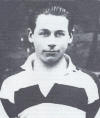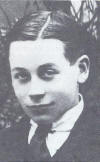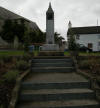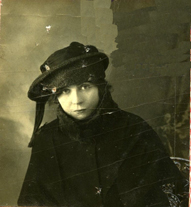Kevin Gerard Barry 20 Jan 1902 – 01 Nov 1920
As a child Kevin liked country life, and went to the national school in Rathvilly. On returning to Dublin, he attended St. Mary’s College, Rathmines up until the school closed in the summer of 1916. At aged 13 he went to the memorial of the Manchester Martyrs William O'Mera Allen, Michael Larkin, and William O'Brien, who were hanged in Manchester on the 23 November 1867 for the rescue of two officer of the Irish Republican Brotherhood. The story of their rescuing their officers and the final words at their own hanging “God save Ireland had such affect he wanted to join the Fianna na hÉireann (Irish Warriors’) but his parent wouldn’t allow it. While in Collage he joined the Rugby team he was a promising player he move from Junior to senior team with ease. In 1918 he moved to the newly established Hurley Team, also taking on the roll of secretary and was one of their most enthusiastic players. The rest of his studies did not suffer; he excelled in the Sciences and Math’s. He won a merit-based scholarship given annually by Dublin Corporation, which allowed him to become a student of medicine at UCD Early school photo
At 16 he was introduced by Seán O’Neill and Bob O’Flanagan to the Clarke Luby Club of the Irish Republican Brotherhood which by that time had been reorganized. The few years he spent in the IRA to his death was very active, he was with his unit when it conducted the raid on the Shamrock Works and taking the weapon consignment that was destined for the RIC. He was apart of the raid on Mark’s of Chapel St gaining more Ammunition and explosives for the cause. On the 1st of June 1920 under the command of Vice Commandant Peadar Clancy, he played a major part in seizing of the British Army post at King’s Inn, Henrietta Street. Barry led a section at the rear of the Building taking the Guardroom where his group capturing the garrison’s arms, of 25 rifles, two Lewis machine guns, plus an important amount of ammunition. 25 British soldiers were captured during the attack all were released as the volunteers withdrew. Apart from the physical gains in the weaponry Barry’s unit action sent an embarrassing message to the British high command and a shock way through the British Parliament. Barry’s superiors, recognized the young man’s dedication and commitment to the cause and promoted him to Section Commander With the Breakup of the Collage term in the summer of 1920 Barry returned to the family farm in Carlow, giving a helping hand to his elder brother Michael in the daily laborers, however he may have had a break from his collage studies in Dublin but his IRA involvement followed him to Hacketstown. He maintain contact with C Company of the 3rd Battalion Carlow Brigade, according to the memories of the then Company Commander Matt Cullen, Barry participated in raids to obtain arms from the homes of the local loyalists’, and the cutting telephone lines to the local police and army barracks. He also helped with the interception of the mail order of learning how much the police knew about the Carlow Brigade and its activities. And when the RIC evacuated the barracks at Hacketstown, he was among those who burned the building to the ground thus deny its use to the forces of the Crown. With the summer over Barry returned to Dublin, and the new Collage term, and a reunion with his IRA Dublin comrades, he did not have to wait long to get active. On the 20th of September 1920 after mass he met with his unit at Bolton Street Dublin where they received their orders. Their orders were to set up and execute an ambush on a British army truck as it was collecting a delivery of bread; the main intension was to capture the soldier’s weapons. With the ambush set for 11.00am Barry saw it gave him time to conduct the ambush and return to class to take an examination that he had at 2.00 PM, however the truck arrived late. The plan sounded simple and easy, they were to be armed with Mauser’s, C company including Barry were to surround the truck and disarm the soldiers, and free them of their weapons and head back to base. Apart from the truck arriving late thing start out as planned, Barry and his group covered the back of the truck, ordering the five soldiers onboard in the rear to lay down their weapon, to which they complied. The next few minutes of events have been a cause of debate for many years, a single shot was fired Terry Golway author of “For the Cause of Liberty” suggests it was possibly a warning shot from a soldier in the front of the truck. The IRA including Barry open fire, sending round into the truck from all directions, Barry’s weapon jammed twice and force him to dive for cover under the truck, with all the commotion Barry did not see that his unit had begun to withdraw, he was left on his own, but soon he was spotted and arrested by the soldiers. The Ambush left one of the soldiers, Private. Harold Washington dead, Two others, Private Marshall Whitehead and Thomas Humphries were both badly wounded to which both later died, two others were slightly wounded. The British Army released the following statement on Monday afternoon: This morning a party of one N.C.O. and six men of the Duke of Wellington’s Regiment were fired on by a body of civilians outside a bakery in Church Street, Dublin. One soldier was killed and four were wounded. A piquet of the Lancashire Fusiliers in the vicinity, hearing the shots, hurried to their comrades’ assistance, and succeeded in arresting one of the aggressors. No arms or equipment were lost by the soldiers To Balance this view other report states the IRA group suddenly emerged from the crowd armed with pistols, converged on the British lorry parked in the street and shouted “Hands up. Hand over your arms.” When the soldiers of the escort did not comply, some of the IRA group opened fire at them while others who had taken positions inside the bakery premises then began to shoot at Sergeant Banks and his two companions. But immediately upon the British escort returning the IRA group’s fire, the latter withdrew without taking any arms, as intended, and leaving one of their number, Kevin Barry, to be captured hiding under the British lorry with a loaded pistol in his hand. Barry was placed in the back of the lorry alongside the body of Private Harold Washington and endured abuse by Washington's comrades. He was transported then to the North Dublin Union. At the Barrack’s he was place under the custody of the Military police he was searched and handcuffed. A short while later, three sergeants of the Lancashire Fusiliers and two officers began the interrogation. He gave his name and his address which was 58 South Circular Road, Dublin, and his occupation as a medical student, but refused to answer any other questions. (Barry’s affidavit below) Barry’s Trial was to be conducted by Court Martial on the 20th October 1920 at 10.00am by nine Army officers, Barry’s Lawyer asked for a short adjourment as to consult his client, this was granted. After the short adjournment Barry announced “As a soldier of the Irish Republic, I refuse to recognise the court.” Brigadier Onslow explained the prisoner’s “perilous situation” and that he were being tried on a capital charge. He did not reply. Sean O’hUadhaigh then rose to tell the court that since his client did not recognize the authority of the court he himself could take no further part in the proceedings He was charged on three counts of the murder of Pte. Marshall Whitehead. One of the bullets taken from Whitehead’s body was of .45 calibre, while all witnesses stated that Barry was armed with a .38 Mauser Parabellum. The Judge Advocate General informed the court that the Crown had only to prove that the accused was one of the party that killed three British soldiers, and every member of the party was technically guilty of murder In accordance with military procedure the verdict was not announced in court. He was returned to Mountjoy, and at about 8 o’clock that night, the district court-martial officer entered his cell and read out the sentence: death by hanging. The public learned on 28th of October of that the date of execution had been fixed for 1st of November The body of Kevin Barry was buried at 1.30 p.m, in a plot near the women’s prison. His comrade and fellow-student Frank Flood was buried alongside him four months later. A plain cross marked their graves and those of Thomas Whelan, Patrick Moran. Thomas Bryan, Patrick Doyle, Bernard Ryan, Thomas Traynor, Edward Foley, and Patrick Maher who were also hanged in the same prison for their part in the War of Independence before the Treaty of July 1921. They became known in Republican circles as the "Forgotten Ten." On the 14th of October 2001over eight years after his death the remains Barry and the 9 other volunteers were given a state funeral and moved from Mountjoy Prison to be re-interred at Glasnevin Cemetery in Dublin. Kevin Barry funeral The cortege of hearses carrying the tricolour-draped coffins paused outside the GPO before funeral mass in the Pro-Cathedral. http://archives.tcm.ie/carlownationalist/2001/10/22/story307.asp KEVIN BARRY The Sworn Statement of Kevin Barry. I, Kevin Barry, of 58, South Circular Road, in the County of Dublin, Medical Student, aged 18 years and upwards solemnly and sincerely declare as follows: On the 20th of September, 1920, I was arrested in Upper Church Street by a Sergeant of the 2nd Duke of Wellington's Regiment and was brought under escort to the North Dublin Union, now occupied by military. I was brought into the guard room and searched. I was then moved to the defaulter's room by an escort with a Sergeant-Major, who all belonged to 1st Lancashire Fusiliers. I was then handcuffed. About 15 minutes after I was put into the defaulter's room, two Commissioned Officers of the 1st Lancashire Fusiliers came in. T hey were accompanied by 3 Sergeants of the same unit. A military policeman who had been in the room since I entered it remained. One of the officers asked me my name, which I gave. He then asked me for the names of my companions in the raid. I refused to give them. He tried to persuade me to give the names and I persisted in refusing. He then sent a Sergeant for a bayonet. When it was brought in the Sergeant was ordered by this officer to point the bayonet at my stomach. The same questions as to the names and addresses of my companions were repeated with the same results. The Sergeant was then ordered to turn my face to the wall and point the bayonet to my back. The Sergeant then said he would run the bayonet into me if I did not tell. The bayonet was then removed and I was turned round again. This officer then said that if I still persisted in this attitude he would turn me out to the men in the barrack square and he supposed I knew what that meant with the men in their present temper. I said nothing. He ordered the Sergeants to put me face down on the floor and twist my arm. I was pushed down onto the floor after my handcuffs were removed. When I lay on the floor one of the Sergeants knelt on the small of my back, the other two placed one foot each on my back and left shoulder and the man who knelt on me twisted my right arm, holding it by the wrist with one hand while he held my hair with the other to pull back my head. The arm was twisted from the elbow joint. This continued to the best of my knowledge for 5 minutes. It was very painful. The first officer was standing near my feet and the officer who accompanied him was still present. During the twisting of my arm the first officer continued to question me for the names and addresses of my companions and the names of my Company Commander or any other officer I knew. As I still refused to answer these questions I was let up and handcuffed. A civilian came in and he repeated the same questions with the same results. He informed me that if I gave all the information I knew, I could get off. I was then left in the company of the military policeman. The two officers, three sergeants and civilian all left together. I could certainly identify the officer who directed the proceedings and put the questions. I am not sure of the others except the Sergeant with the bayonet. My arm was medically treated by an officer of the Royal Army Medical Corps attached to the North Dublin Union the following morning and by the prison hospital orderly afterwards for 4 or 5 days. I was visited by the Court Martial Officer last night and he read the confirmation of sentence of death by hanging to be executed on Monday next and I make this solemn declaration conscientiously believing same to be true and by virtue of the Statutory Declarations Act, 1835. Declared and subscribed before me at Mountjoy Prison in the County of the City of Dublin, 28th October, 1920. (Signed) MYLES KEOGH, a justice of the peace for said County. KEVIN GERARD BARRY Source: Terry Curran Please report any links or images which do not open to mjbrennan30@gmail.com |





